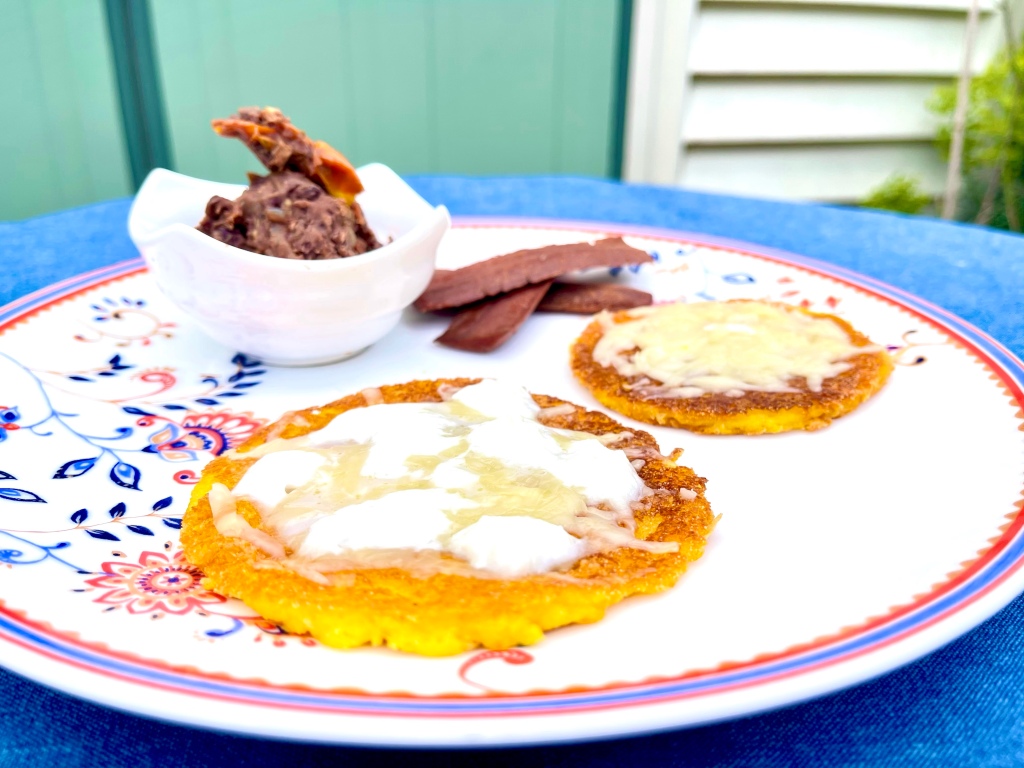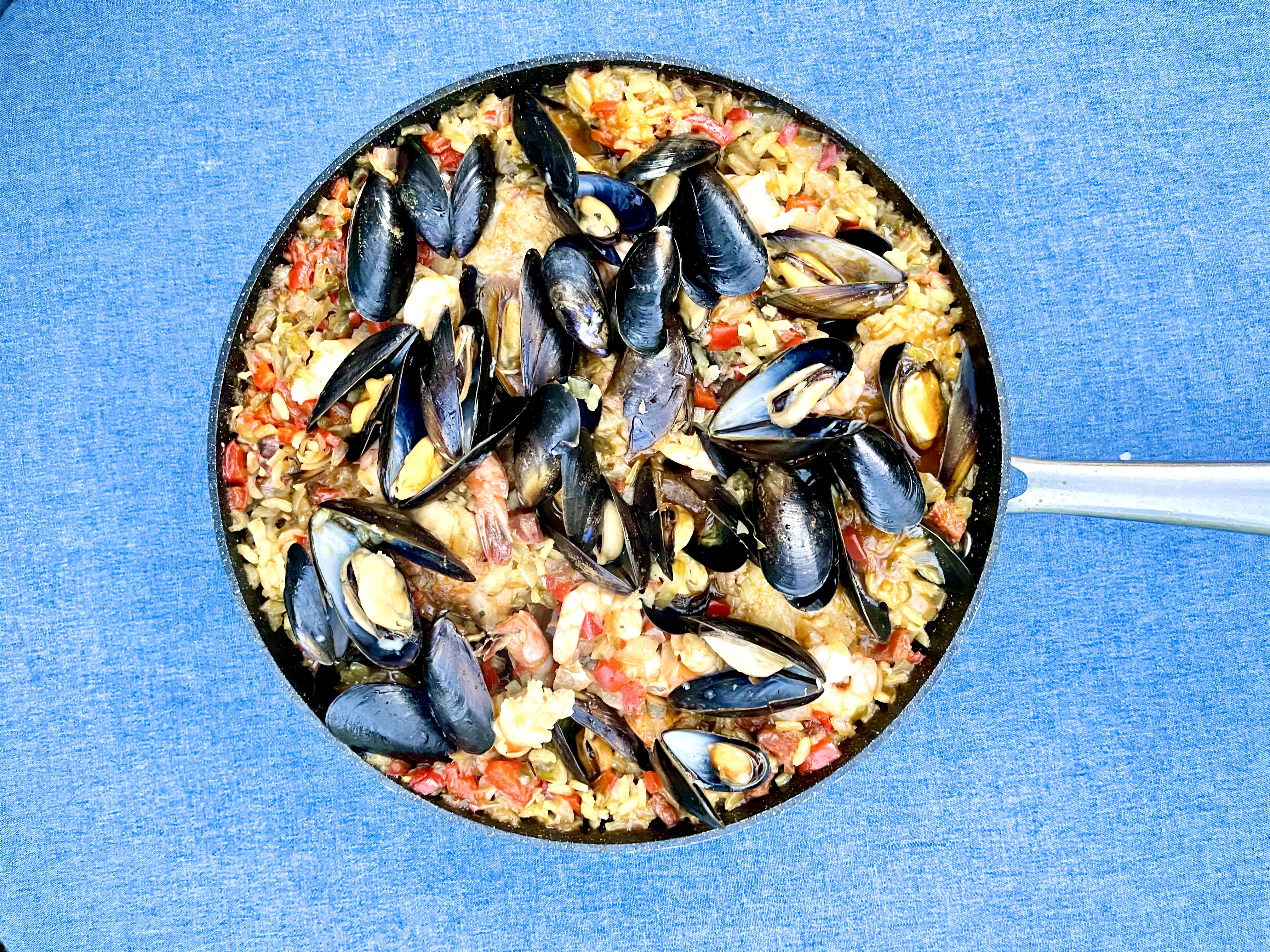gluten free
ANA MARIA & JUAN’S AREPAS DE CHOCLO
This is a very special recipe shared with us by Ana & Juan, two siblings born in Colombia and now living in different parts of the world. Sharing and making recipes, such as these sweetcorn arepas (arepas de choclo), from places we call home help us feel closer to each other when we are too far to hug. Thank you Ana Maria Millan and Juan for sharing a tasty treat and transporting us to your Mum’s Colombian Kitchen table, in that flat that was bought precisely because it could fit a table large enough to gather friends and family as its focal point of togetherness. Much love and respect to Ana’s wonderful Colombian Mama and all the Mamas many of us miss from afar! Thank you to Ana who shared this recipe and her words, which make up most of this post. Ana was born in Colombia and has been living in the UK for nearly 20 years.
Arepas are a traditional food of Latin America, and they come in many varieties. Some are made with different types of corn (e.g masa harina) or rice flour. They are eaten as part of a meal or as a meal itself. This recipe is made with young sweetcorn (choclo) and a mix of flours.
Ana says, ‘I like it because it is sweet, and also because it helps me bring together some of the components of my multi-cultural family: a Colombian recipe with Dutch cheese. My husband is Dutch so we try to make the most of both worlds. Although I only started making arepas after moving to the UK, this recipe takes me home, to my mum’s kitchen. The ideal way to have these is with Colombian hot chocolate, with cheese inside (but that’s another story).’
‘For us sharing food is very important. Growing up we always had dinner together – it was the time of the day when we would sit together and talk about our day and anything that was happening. And, that is something that I do with my family too – dinnertime is family time.’

What (feeds 2)
- 2 cups or 340g sweet corn kernels (use defrosted or tinned + drained)
- ½ cup or 110g flour – use either masa harina OR gluten free flour OR a mix of gluten free and fine cornmeal ground furtner in a stone pestle or mortar
- 1 teaspoon of softened butter or coconut oil
- 4 Tbsp. or around 60ml milk (dairy or vegetable)
- Pinch of sugar
How (30min)
- Place the sweetcorn in a food processor until it is mushy, but not smooth. Some kernels should be visible.
- Heat the milk and melt the butter of choice.
- Add the flours and sugar to the blender and blend till smooth.
- The batter should look like thick porridge but it should not be too stodgy. If it is too thick, dilute it with some more milk.
- Use a large non-stick pan to fit many small pancakes or a smaller to make 2-4 large ones.
- Heat a little bit of butter until melted. Pour the mixture in small or larger circle shapes. Flatten to about 1cm thickness (not too thin but a little bit more like an American or blueberry pancake).
- Cook on low heat until it is nice and golden for about 3-5 minutes.
- Flip over carefully so it doesn’t break. Put the sliced or grated cheese on top and cook for another 3-4 minutes. You can fold in half and flip over to melt cheese further.
- Serve and enjoy.
Lia’s Tips
- My perfect Ana & Juan arepas used a mix of gluten free flour and fine cornmeal (used for cornbread) ground down further in a stone pestle and mortar.
- Gluten free flour arepas were the second best.
- Heating up the milk to melt the butter worked really well.
- After my third attempt, I realised that the best way to blend the mix well was to add all the ingredients to the blender after first blending the corn kernels
- I used round metal moulds/cooking rings to make my round arepas. It helped my shape them and spread them thinner but they were mostly 2cm thick. I made mine about 10cm wide so the recipe quantity yielded between 8-10 small arepas.
- I LOVED using oat milk and coconut oil in my arepas. Ana is right it enhances the arepa sweetness
- I LOVED Ana’s Colombian/Dutch family tradition of using Edam cheese for the filling. It’s saltiness counterbalanced the arepa sweetness perfectly.
- Torn shreds of mozzarella was the second best cheese to use.
- I didn’t always fold the arepa as mine were mostly small.
- I loved serving with vegan or crisped up real bacon. Yum!
- Yes, I did the full Colombian thing and had chocolate with those. However, sweetened milky coffee was amazing too.
LUCY’S PAELLA
This is a recipe from our community and friends. Thanks to the the lovely Lucy Byrnes for the permission to share and adapt a recipe that makes her feel festive and takes her to a happy place she wants to share with us.

Lucy’s recipe feeds 4-6. It helped us see how easy is it to make paella at home to share with loved ones at all times and particularly during festivities.
What:
- 6 chicken drumsticks & wings (around 500g)
- 75g chorizo, sliced
- 2 peppers, Lucy recommends yellow & red for the colours
- 2 medium onions, finely chopped
- 3 cloves of garlic, crushed
- ½ -1 tsp smoked paprika
- 2-6 strands of saffron
- 2 pints or 1200 litre chicken or other stock (1 or 2 stock cubes depending on taste)
- 200g-250g paella rice
- 500-700g sea food you want (Lucy likes big prawns with the heads on and mussels. Use half and half)
- 2 Tbsp. olive oil
- Lemon to serve
- Salt for chicken
How:
- Get the mussels soaking for a few hours, scrub well to remove grit and pull the beards off.
- Season the chicken with generous amount of salt. Set aside whilst you prepare the veg.
- Prepare the hot stock, add the saffron, a couple of prawn heads and a mussel or two and set aside.
- Use a paella pan or shallow cast iron pan with a lid instead.
- Heat a couple of tablespoons of oil in the pan and lightly brown the chicken both sides turning occasionally for about 5 minutes.
- Add the sliced chorizo. Cook for a further minute.
- Take the chicken and chorizo out and set aside making sure the fat stays in the pan.
- Add the chopped onion to the pan (no need for extra oil) and fry until it starts to caramelise. Add the sliced peppers and cook for a couple more minutes.
- Stir in the crushed garlic, a small amount of saffron and the rice and stir it well.
- Return the chicken and chorizo to the pan.
- Add the stock first bit at a time, then the rest of it after a couple of minutes. Stir well and simmer for about 15 minutes.
- At this point the rice probably needs between 5 and 10 minutes so you need to add the mussels.
- Cover and after 3-4 minutes add the big prawns.
- Then turn the heat off and let it sit with the lid on for 10 minutes so that the rice can soak up all the juices.
- Squeeze some lemon juice when you serve and a nice cold glass of white wine and you are sorted as Lucy says.
Lia’s Kitchen Notes
- If you have no paella rice, you can use risotto or pudding rice. Just wash once to clear some starch.
- You can add the paprika to the chicken to marinade.
- Stir fry the rice until it starts getting translucent before adding the stock.
- Once you add the stock, stir once and then cook uncovered for 15-18 min.
- In honour of the Valencian paella I like my rice slightly caramelised at the bottom. Only add the mussels in when you are sure most of the water had evaporated.
- The Spanish do not usually use chorizo but we love it as the dish It reminds us of the Creole Jambalaya, which uses long grain rice and spicy southern sausages.
- We used a ten centimetre deep pan around 25cm wide. It just about fit 3 drumsticks, 2 chicken thighs, 500g mussels and 200g prawns.
- We used chicken on the bone and with the skin on. I like crispy skin and the flavour the bone adds.
#paella #spanishfood #food #recipes#worldflavours #globalkitchen #instafood #celebrate #easyrecipes #lucyspaella #liaskitchen
#paellarecipe #yourrecipe #recipesfromthecommunity
Poached eggs with avocado and chilli potatoes
You don’t need to wait for the weekend for this beautiful dish. It’s a great light midweek dinner or lunch as well as the perfect weekend brunch.
 We live in the age of avocado craze so admittedly this is not the first time you see a recipe like this one. But I was asked to blog the recipe by one of my followers when I posted a photo on social media…and here it is.
We live in the age of avocado craze so admittedly this is not the first time you see a recipe like this one. But I was asked to blog the recipe by one of my followers when I posted a photo on social media…and here it is.
I love using potatoes instead of bread but sourdough or other bread is a great alternative if that’s what you have handy.
Poached eggs are an absolute treat for me but if you like scrambled or fried don’t let me stop you.
And Dukkah, the Egyptian spice condiment the recipe for which is on my blog, lifts flavours and as another page follower said ‘makes everything taste better’. So maybe have a go at making it this week.
I love smoked salmon with avocado but you can easily omit it and replace with anything you fancy, for example sundried tomatoes work really well with this dish, as does chorizo and other spiced sausage if you are a carnivore.
Ingredients
Feeds 2
- 2-4 eggs, depending on your hunger
- 1 avocado, halved and thinly sliced
- 170g new potatoes
- 60g smoked salmon, half a packet
- Half a lime
- 1/4 tsp chilli and garlic paste or 4 drops of Tabasco sauce
- A few slices baby plum or cherry tomatoes
- Salt
- Olive oil
- White vinegar
- 1/2 tsp Dukkah spice mix
Preparation
30 minutes
- Wash and quarter the new potatoes (skin on) and simmer for 10 minutes, till cooked.
- Drain and mix in a bowl with the chilli sauce, a pinch of salt and a careful splash of olive oil.
- Squeeze the lime juice on top of the avocado slices and sprinkle carefully with a bit of sea salt.
- Slice the smoked salmon into thin slices.
- To poach the eggs bring a pot of water to the boil.
- Add a tablespoon of white vinegar.
- With a fork or spoon stir quickly in the middle to create a whirlpool and quickly crack an egg into its centre.
- Simmer for 3-5minutes for a runny poached egg or a bit longer if you like it firmer.
- Cook one egg one at a time.
- Serve the egg(s) on a bed of potatoes, topped with the salmon strips and the avocados on the side.
- Add sliced baby tomatoes on the avocado if that takes your fancy.
- Sprinkle the dish with the Dukkah spice mix or a bit of salt.
Lia’s Tips:
- You can also add more mild chilli sauces of your choice like Cholula or the coriander chilli sauce from Blaencamel market stall in Cardiff.
- A dollop of yoghurt is mighty fine with this dish too.
Savoury cornmeal cake
This is a recipe I have been playing with for years and I finalised it recently whilst delivering the Love Food Hate Waste campaign in Roath. I was looking for recipes in my notebook that can help people use their leftovers and what they have in the fridge/freezer. The savoury cake was one our roadshow freebies and was sampled at our last Love Food Haste Waste event on 10 Mach at Cardiff Students’ Union in return for pledges to take action to reduce waste.
It is a delicious recipe that can be adapted to help you use greens and smaller quantities of leftover vegetable. The batter can remain the same and you can be as creative and daring as you like with what flavours you create. You end up with an amazing tasty snack on its own or with some relish or chutney on top and a (gluten-free) substitute to bread which is fantastic with soups or a tin of baked beans.
Cornmeal is a basic ingredient for one of my favourite Greek breads called Bobota. Grated pumpkin and marrow with cornmeal and feta cheese has always been one of my most favourite bakes that my southern Greek Granma Vasiliki used to make for us. And five years ago the lovely Zoe English, of Bird to Market, handed over Nenneh Cherry’s cornbread recipe to me after my excited squeals on tasting it for the first time in my life. So this savoury cake recipe is born from all these influences and is fast becoming one my favourite things to make this spring. I have adapted it to be gluten free – through the use of gluten free plain flour. And with courgette and tomato season approaching and rainbow chard already on the tables at our Farmers’ markets I am very excited for the many versions of the savoury cakes you could be imagining. Enjoy!
Ingredients (1 Bundt or other round 23-25cm baking tin)
- 350g Plain flour, preferably gluten free mix
- 250g Cornmeal (coarse or medium)
- 4 tsp Baking powder
- 80g Sugar (caster)
- 100g Butter melted
- 2 Eggs
- 450-480ml Milk
- 1-2 pinches of salt
- Some extra butter and flour for lining the baking tin
- 1 Small bunch fresh basil or other mixed or frozen herbs, including stems (around 30g)
- 225g Cherry or mini plum tomatoes (up to 300g)
- 1 Onion
- 2 medium or 1 large courgette diced OR
- 1 aubergine diced
- 1 Medium courgette coarsely grated
- 150g grated cheese, parmesan and cheddar mixed (or whatever you have available)
- salt & paper to season
Olive oil for the frying
Preparation (1hr and 15 minutes)
- Prepare your vegetable mixture first to allow enough time to cool.
- Fry the sliced onion with a pinch of salt, cover and let to nearly caramelise whilst you prepare the rest.
- Dice the courgettes or aubergine and halve the cherry or plum tomatoes.
- Add the courgette or aubergine with another pinch of salt and fry for 5 minutes.
- Add the tomatoes and basil, stir and cover until all ingredients soften- for around 5 minutes.
- Taste and season with salt and pepper if needed. Remove from heat to cool down.
- Grate the last courgette and the cheese.
- Mix the flour, cornmeal and baking powder.
- Add the rest of the dough ingredients and mix well so that there are no lumps.
- Add your fried ingredients, raw courgette and cheese.
- Pour into a lined baking tin and bake on 180 Celsius for 40-50 minutes or until a skewer comes out clean.
Lia’s Tips:
- The batter should be moist but not too runny. You can add 450ml of the milk first and see if you need to add more after you add the tomatoes and vegetable.
- You can use spinach and other greens such as Kale. Feel free to experiment with various herbs ad ingredients. Use what you have in the fridge and for inspiration on flavours look up focaccia recipes.
- This is a great recipe for using those herbs that you have in the freezer or the ones that are about to go off in the fridge!
- For a bread tin and smaller quantity of the cake halve the recipe ingredient.
- The cake rises quite a lot and it keeps well in the fridge for about a week.

